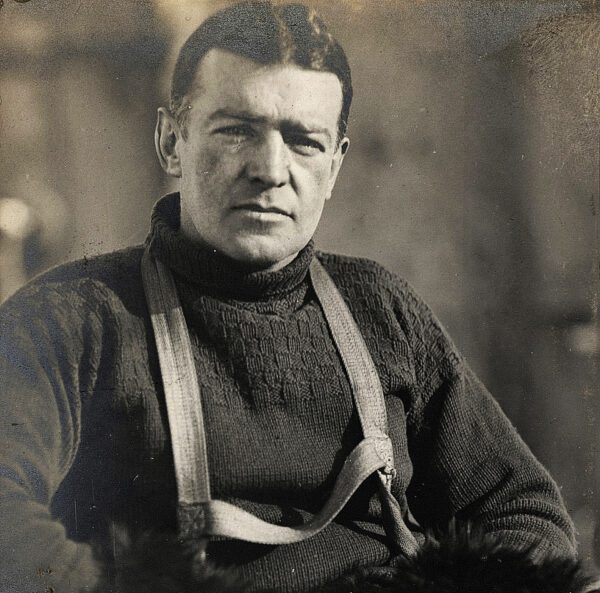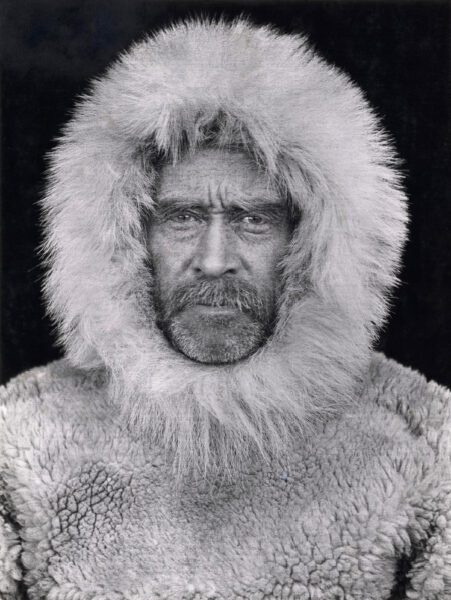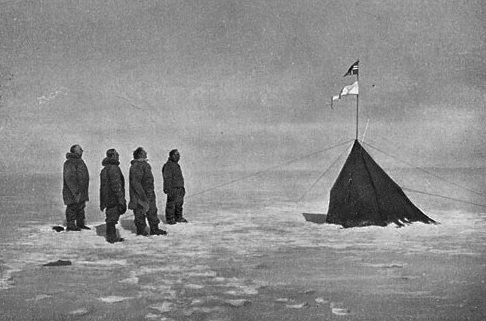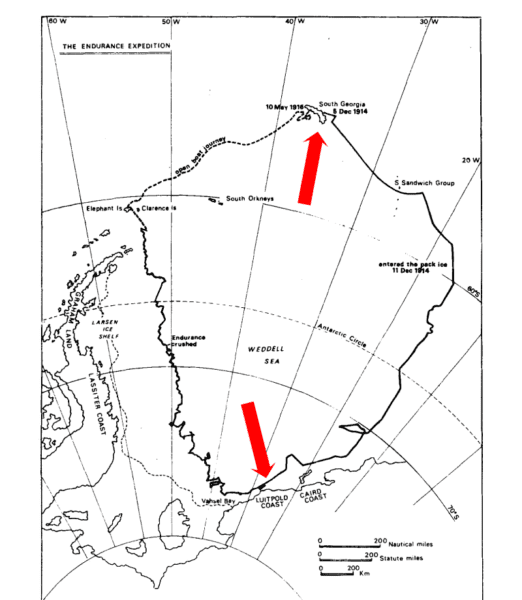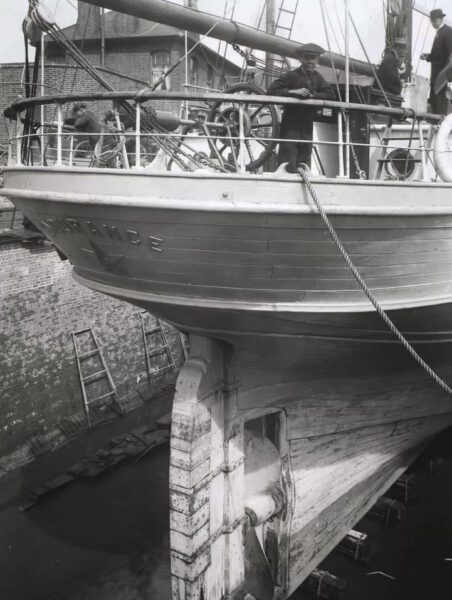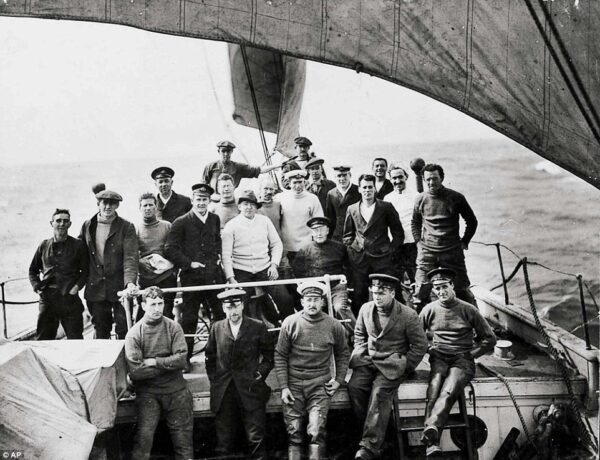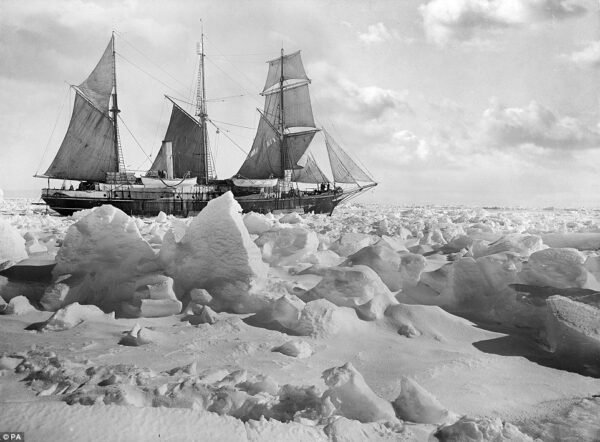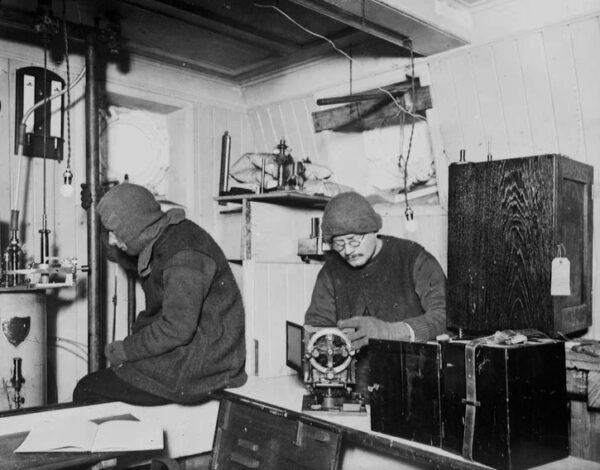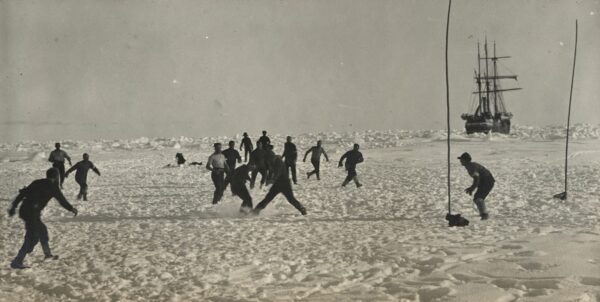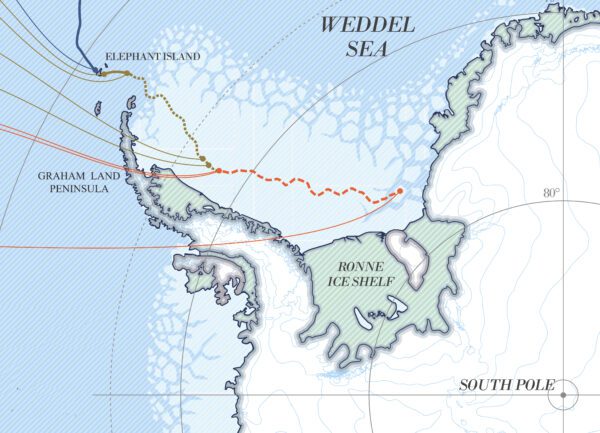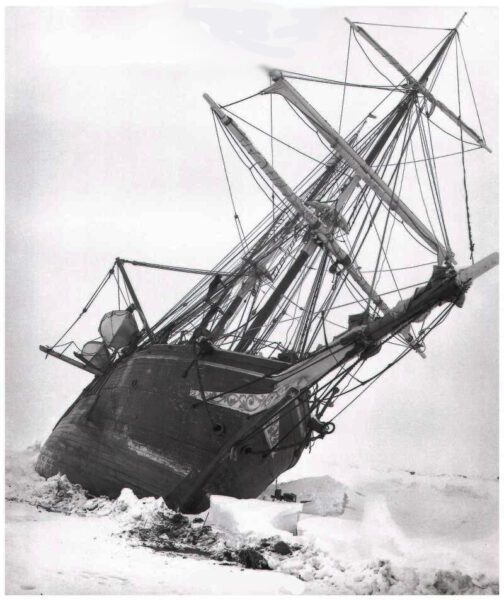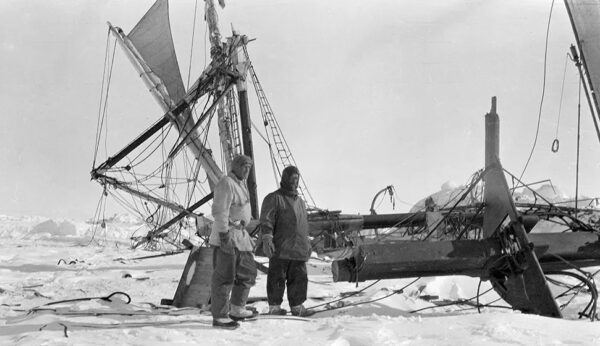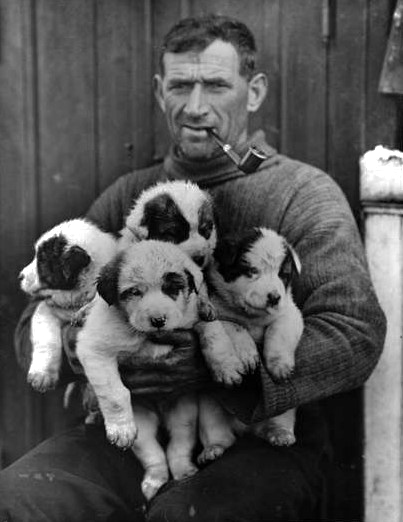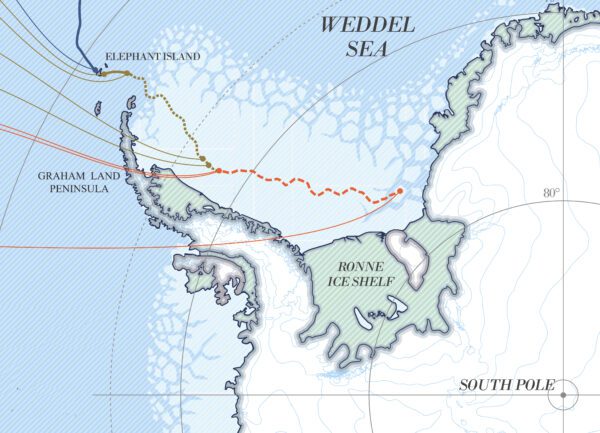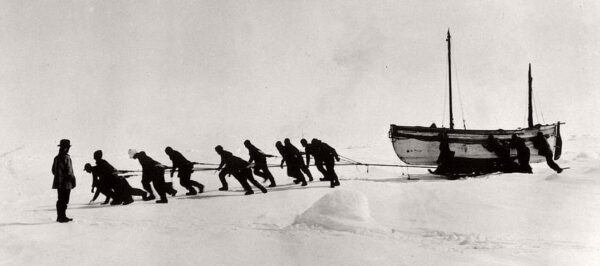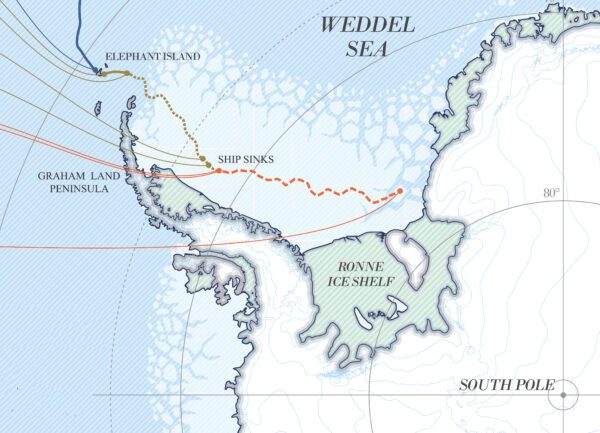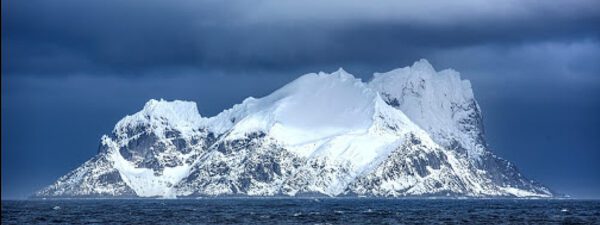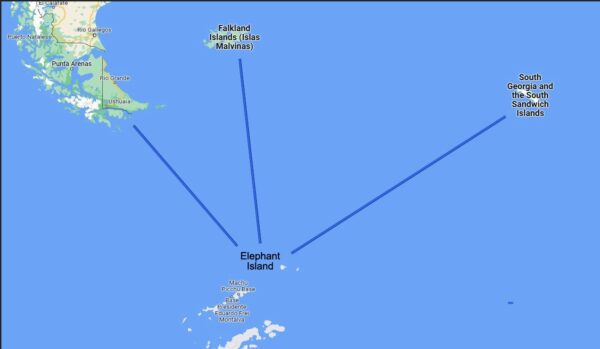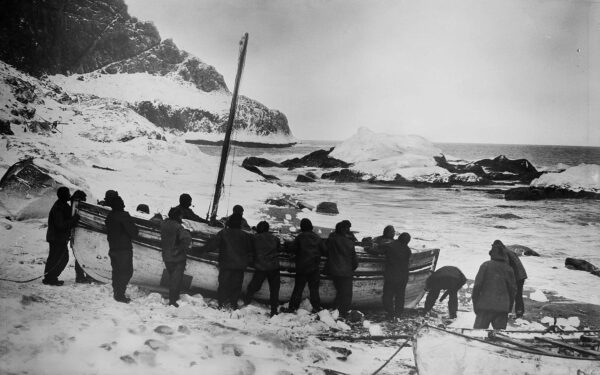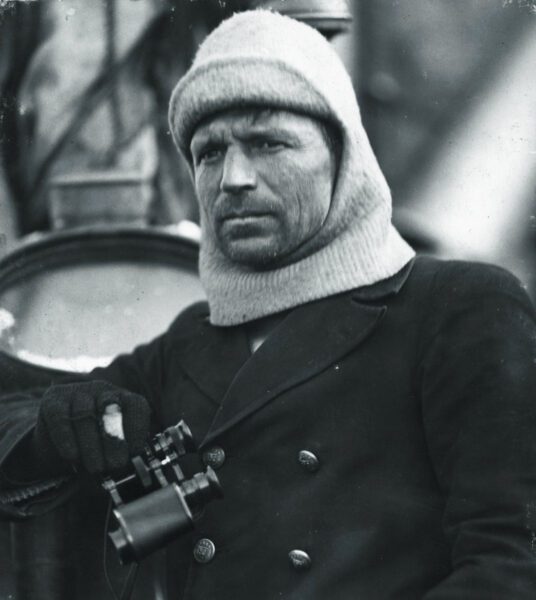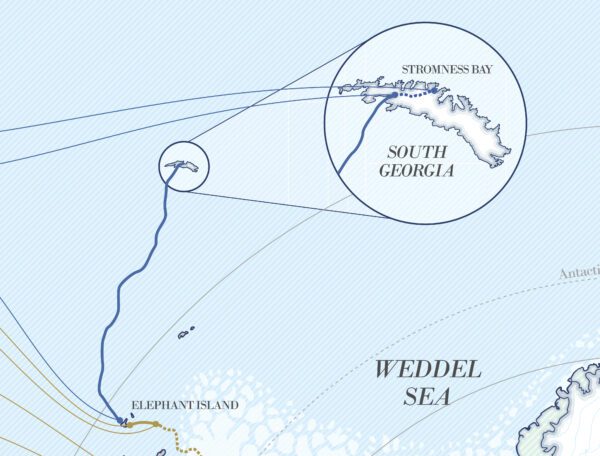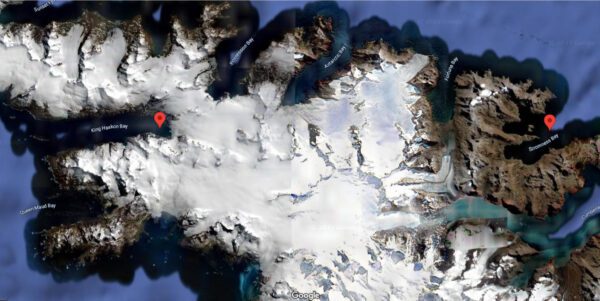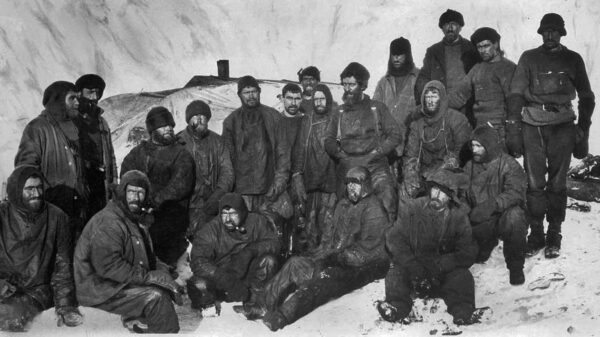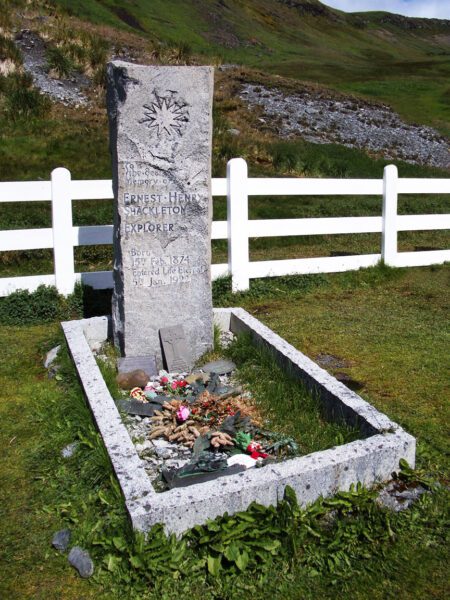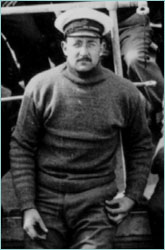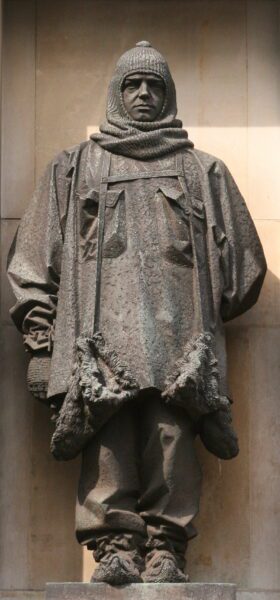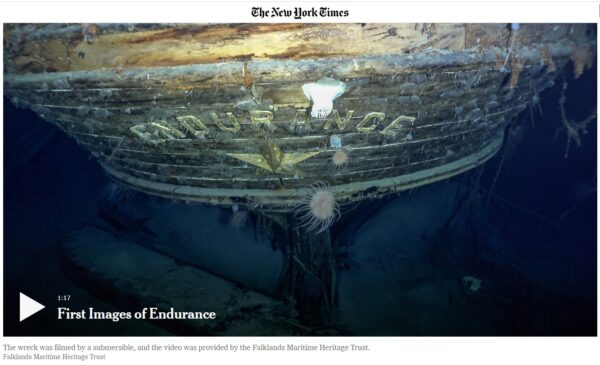Have There Ever Been More Courageous Men?
- Post AuthorBy Jared Taylor
- Post DateFri Mar 10 2023
This video is available on Rumble, BitChute, and Odysee.
I’m going to tell you what may be the most heroic story of courage and endurance in history. It’s the story of Ernest Shackleton’s Antarctic expedition of 1914 to 1916.
Shackleton, an Anglo-Irish polar explorer, had been deeply disappointed that the British had been beaten to the North Pole by the American Peary expedition in 1909 and that Norwegians under Roald Amundsen had been the first to the South Pole.
Credit: Robert Peary, Public domain, via Wikimedia Commons
Credit: Olav Bjaaland (1873–1961), Public domain, via Wikimedia Commons
The Imperial Trans-Antarctic Expedition would save Britain’s honor.
It was to be the first crossing of the continent, following the line on this map – crossing the pole, then continuing on to Ross Island.
Another team was to leave supplies in several places from the interior to the coast, where a ship would pick up Shackleton and his men.
The expedition was an utter failure. The men never even set foot on Antarctica. And yet, even in failure – in an ordeal that lasted 617 days for most of the men – it was one of the all-time great achievements against incredible odds.
The plan was to sail from South Georgia Island in the South Atlantic, indicated at the top of the image, down to the Luitpold Coast, also indicated, transfer to land, and make the trek across the continent with dog teams.
Their ship was the Endurance, shown here in drydock.
She was purpose-built for polar exploration, a 144-foot barkentine, with a small auxiliary steam engine. You can see the propeller at the bottom of the picture. The ship was made of immensely strong beams and planking because Shackleton knew she would face tremendous pressure from ice floes.
Shackleton had no trouble attracting a crew. He chose half-a-dozen key men from veteran sailors and explorers he knew personally, and advertised for others. He got 5,000 applications, including a group of three women who said they would be willing to wear men’s clothing. The rest of the group, shown here onboard the Endurance, was filled out by Shackleton almost by intuition.
He interviewed the men who seemed most promising, but there is no record that he spent more than five minutes deciding whether to take a man.
The group was dominated by Englishmen, but there were four men each from Scotland and Ireland, and one each from Wales, Australia, New Zealand, and even the United States – all English-speaking white men.
The initial voyage, from South Georgia Island, down through the pack ice was successful, and the Endurance got within sight of land.
However, on January 18, 1915, 44 days into the voyage, the ship was caught in pack ice and could not be broken free. This was in the Arctic summer, and Shackleton decided to spend the winter on the ship, wait for next year’s thaw, and proceed with the expedition. (See map.)
This meant months of waiting, but the interior of the ship could be heated and was relatively comfortable.
Shackleton kept the men disciplined, but there was not that much to do. Here they are playing soccer on the ice with the ship in the background.
The dog teams were exercised on the ice and even had sled races. The ship had not been supplied with food for an extra year, so the crew hunted penguins and seals. Here the cook skins a penguin for dinner.
Wind and currents gradually pushed the packed ice north. As you can see from the dotted orange line on this map, the ice pushed the ship hundreds of miles towards the tip of the Graham Land Peninsula.
What was much worse, the pressure of the ice became so great that the men could hear beams and boards snapping under the pressure. It became impossible to sleep because of the sound of cracking beams as loud as artillery. As you can see in this picture, the Endurance was at first pushed right over by the ice.
The men unloaded the stores and set up camp.
It was much colder with only tents for shelter. This is a warm day. Eventually the ice swallowed and destroyed the ship. Sled dogs are looking at what used to be their home.
Eventually, there was practically nothing left of the Endurance above the surface, and on November 21st, 1915, after 307 days stuck in the ice, she sank.
The men had tied the Union Jack to its highest point, so she would be flying her colors as she went down.
The expedition was now in a terrible fix. It had been nearly a year since they left South Georgia. Radio communication was impossible. No one knew where they were. They had only one goal: get out alive. Every detail was under the command of Shackleton, whom the men addressed as “Boss.”
Seals and penguins are seasonal, and soon there was none to hunt. There wasn’t enough food for the dogs, and Shackleton gave the unpopular order to kill and eat them. Some had been born during the voyage and the men loved them. Here is Irishman Tom Crean holding puppies.
Credit: Frank Hurley (1885–1962), Public domain, via Wikimedia Commons
Shackleton decided to lead the men towards a point on the Graham Land Peninsula, where he knew there was a store of food.
But this was not just a matter of walking across ice. They would eventually have to cross open water to reach land. That meant dragging the three lifeboats they had salvaged from the ship. Here, men are hauling the largest of the three, the James Caird, but this is a rare patch of smooth ice and snow.
The pressures that had broken up the Endurance pushed up huge ridges. Men carved out the equivalents of mountain passes to push the boats through. After several days of exhausting labor, Shackleton realized it was impossible, and gave the order to halt. They would have to ride the ice north until it broke up, and dumped them into the ocean.
But this was a terrifying prospect. As the months went by, the ice began to crack. Shackleton moved camp several times to stay on what he hoped would be a floe big enough to stay intact until it reached the sea. If the men launched too early, floes could slam together and crush the boats.
Their floe kept cracking. Shackleton posted watches every night, and several times, the men were roused by the terrifying news that the ice had split right through camp. They had drilled for this emergency, and every time, managed to throw supplies across the cracks, and float boats across to keep the camp together. Once, the floe split directly under a tent and men fell into freezing water. One man, caught in his sleeping bag, was hauled out just before the two plates of ice slammed back together.
Finally, on April 9th, at the end of the brown dotted line, Shackleton decided that the ice floe was so small, and the sea open enough to launch the boats and head for Elephant island.
For six miserable days – the solid brown line to the island – the men sailed and rowed through freezing weather and stormy seas. Their cold-weather gear was nothing like modern synthetics, and they didn’t even have oilskins. Their clothes were for tramping across snow, not for keeping out seawater.
The first two nights, the men tried to drag the boats onto ice so they could cook food and sleep in tents rather stay in the tiny, rocking boats, packed with gear. But the ice kept breaking up, and the men had to strike camp in a panic and scramble for their lives back into the boats. For the rest of the trip, they stayed cramped in the boats, freezing spray constantly in their faces, taking turns at the oars and tiller, trying to feed themselves, relieving themselves over the side. Always wet. Never able to sleep. Every man with frostbite. One was getting gangrene.
Finally, on April 15, the exhausted men landed on uninhabited Elephant Island, shown here.
Credit: Map data (c) Google, Image capture: Nov. 2014
They soon realized that their little beach would be under water at the highest tides, so they forced themselves back into the boats and found a better cove. At least there were seals and penguins to eat.
But no one knew they was there. Help would never come.
Shackleton decided to take five men in the most seaworthy boat, and sail for help. The closest land was Tierra del Fuego, the tip of South America, the next closest was the Falklands, almost due north, but the safest plan – because of winds and currents – was to sail back to South Georgia, across more than 800 miles of what is called the Drake Passage, famous for some of the stormiest seas on earth.
Shackleton and his men set off in the James Caird, here being launched on April 24.
It was fall in the Southern Hemisphere. The weather was getting colder. Here are videos [6:02 – 6:262:11 – 2:59] of storms in the Drake Passage taken from modern, ocean-going ships. These are the waters Shackleton and his men sailed through for 16 horrible days and nights in screaming gales, as the temperature plummeted to near-zero. During storms they had to strip off all sail, and set a sea anchor to keep the bow into the wind, and pray that a giant wave would not crush or capsize the boat. So much ocean spray froze on the boat it became so top-heavy it might capsize. Men had to crawl out in the howling wind and chip off the ice. This voyage alone was a great seafaring achievement.
Shackleton’s navigator, Frank Worsley, had to take sextant readings from a boat bucking like a horse, whenever the cloud cover broke enough to see the sun.
If they had blown past South Georgia into the open ocean, they would have certainly died. They could not have sailed back into the wind to safety.
One of their water casks became fouled and by the time they reached land, they were not only hungry, frostbitten, covered with sores and boils, but frantic with thirst. They spent a harrowing day trying to find a place to land where the boat would not be crushed against rocks. On May 10, 1916, they finally put in to shore, more dead than alive.
The ordeal wasn’t over. They were on the opposite side of South Georgia Island from Stromness Bay, where the whaling station was. This was where they had set out 522 days earlier.
The James Caird had been damaged when they landed, and Shackleton decided two of his men would not survive another trip on the water. This meant hiking across the island. Here is what they had to cross, from the head of King Haakon Bay to Stromness Bay, over terrain so rough, no one had ever attempted it.
Credit: Google Maps Data (c) 2023
Shackleton waited for nine days, resting and hoping for good weather. He chose the two healthiest men, his navigator Worsely, and the Irishman Tom Crean to go with him, and left the three others at King Haakon Bay.
The men had no climbing equipment. They had salvaged two-inch screws from the Endurance, and drove them through the soles of their boots as makeshift crampons.
The crossing itself was an extraordinary accomplishment – 36 hours over unnamed mountains and glaciers, some so steep, the men had to hack steps into the ice. Going down was worse: lower a man on a rope, where he hacked out steps, join him, and lower him further, while he hacked out more steps. Worsley called some of the ice faces as steep as church steeples. Shackleton allowed no sleep; if the men drifted off, they would freeze to death, and if they failed, there was not hope for any of the other men. Without a proper map, they mistook landmarks several times, and spent agonizing hours backtracking.
They stumbled into the whaling station, so dirty, bearded, longhaired, and haggard that two 11-year-old boys they met ran screaming in terror. Men at the whaling station, who had given them up for lost, were astonished. The next day, Shackleton had a boat sent back to King Haakon Bay to pick up the other three men.
What about the 22 men back on Elephant Island? Here they are, minus one, whose frostbitten toes had to be amputated to save his left foot and was resting. In the background, you can just see the overturned boats under which they sheltered, with a makeshift chimney set up to cook food inside.
They spent an interminable 137 days waiting for help. They had no way of knowing that it would take three months and 10 days – and four attempts – for Shackleton to rescue them. There was too much pack ice around Elephant Island to get close enough even to send a signal to let the men know help was coming.
In the end, every man was saved.
It may be hard to believe, but after all this, most of the Englishmen were conscripted to fight the world war, which had begun before the expedition set out. Two were killed in action, one died of disease, and several were badly wounded. Shackleton volunteered for combat but he was 43 and weakened by his travels. Instead, he had a successful lecture tour, but grew tired of it, and organized another expedition to the Antarctic that set out in late 1921. He suffered a heart attack on board ship, and his wife asked that he be buried on South Georgia Island.
Alexander Macklin, who had been with Shackleton on the earlier expedition and signed up for his last, wrote this at his gravesite:
Credit: Lexaxis7, CC BY-SA 3.0, via Wikimedia Commons
“I think this is as ‘the Boss’ would have had it himself, standing lonely in an island far from civilisation, surrounded by stormy tempestuous seas, & in the vicinity of one of his greatest exploits.”
A statue of Shackleton now stands outside the Royal Geographical Society in London, a tribute to a man whose iron determination and inflexible leadership turned an utter failure into an inspiring stories of heroism. His example has never been more relevant.
Just this month, a submersible found Shackleton’s ship, 106 years after it sank, nearly 10,000 feet down. Because shipworms cannot live in such cold water, the ship is beautifully preserved – including its nameplate: Endurance.
- Post TagsBritain
